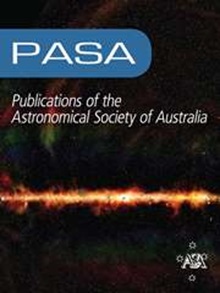用于默奇森宽域阵列的同源快速射电暴搜索管道
IF 4.6
3区 物理与天体物理
Q1 ASTRONOMY & ASTROPHYSICS
引用次数: 0
摘要
我们展示了利用默奇森宽场阵列(MWA)的实时非相干波束进行快速射电暴(FRB)搜索的共生管道演示版本。该管道的主要科学目标是来自局域宇宙的附近亮FRB(包括来自SGR 1935+2154的银河系FRB),它们是探测FRB原生体和了解这些极高能事件的物理机制的最佳候选者。最近,LOFAR(低至 110 MHz)、绿岸望远镜(350 MHz)和 CHIME(低至 400 MHz)对 FRB 的探测证明,有一批 FRB 可以在 350 MHz 以下被探测到。新的 MWA 波束形成器被称为 "MWAX 多波束形成器",可以形成多个非相干和相干波束(参数不同),以适应任何正在进行的 MWA 观测。其中一个波束目前用于搜索 FRB(测试频率分辨率为 10 kHz,时间分辨率为 0.1 至 100 ms)。第二个波束(频率和时间分辨率分别为 1 赫兹和 1 秒)用于地外智能搜索(SETI)项目。本文重点介绍 FRB 搜索管道及其在选定的已知亮脉冲星上的验证。该管道使用 FREDDA 实现的快速色散测量变换算法(FDMT)进行单脉冲搜索。最初是在标准 MWA 观测中进行测试,最近则对 11 颗亮脉冲星样本进行了专门观测。脉冲星 PSR J0835-4510 (Vela)一直被用作数据质量的主要探测对象,因为它的折叠轮廓总是在 200 - 230MHz 频段内被探测到,典型信噪比为 10,与预期一致。同样,低色散测量脉冲星 PSR B0950+08 也总是在 140 - 170 MHz 频段被探测到折叠剖面,并且是迄今为止唯一被探测到单脉冲的天体。我们介绍了在目前有限的单个 MWA 粗频道(1.28 MHz)观测带宽和未来升级后的 12.8 MHz(10 个频道)带宽系统中搜索灵敏度的估计值。根据预期的灵敏度和现有的 FRB 率测量结果,我们预测 FRB 的探测率在每年几到几十个之间,但由于低频的 FRB 率未知,不确定性很大。本文章由计算机程序翻译,如有差异,请以英文原文为准。
A commensal Fast Radio Burst search pipeline for the Murchison Widefield Array
We present a demonstration version of a commensal pipeline for Fast Radio Burst (FRB) searches using a real-time incoherent beam from the Murchison Widefield Array (MWA). The main science target of the pipeline are bright nearby FRBs from the local Universe (including Galactic FRBs like from SGR 1935+2154) which are the best candidates to probe FRB progenitors and understand physical mechanisms powering these extremely energetic events. Recent FRB detections by LOFAR (down to 110 MHz), the Green Bank Telescope (at 350 MHz), and CHIME detections extending down to 400 MHz, prove that there is a population of FRBs that can be detected below 350 MHz. The new MWA beamformer, known as the ‘MWAX multibeam beamformer’, can form multiple incoherent and coherent beams (with different parameters) commensally to any on-going MWA observations. One of the beams is currently used for FRB searches (tested in 10 kHz frequency resolution and time resolutions between 0.1 and 100 ms). A second beam (in 1 Hz and 1 s frequency and time resolutions respectively) is used for the Search for Extraterrestrial Intelligence (SETI) project. This paper focuses on the FRB search pipeline and its verification on selected known bright pulsars. The pipeline uses the FREDDA implementation of the Fast Dispersion Measure Transform algorithm (FDMT) for single pulse searches. Initially, it was tested during standard MWA observations, and more recently using dedicated observations of a sample of 11 bright pulsars. The pulsar PSR J0835-4510 (Vela) has been routinely used as the primary probe of the data quality because its folded profile was always detected in the frequency band 200 – 230MHz with typical signal-to-noise ratio > 10, which agrees with the expectations. Similarly, the low dispersion measure pulsar PSR B0950+08 was always detected in folded profile in the frequency band 140 – 170 MHz, and so far has been the only object for which single pulses were detected. We present the estimated sensitivity of the search in the currently limited observing bandwidth of a single MWA coarse channel (1.28 MHz) and for the upgraded, future system with 12.8MHz (10 channels) of bandwidth. Based on expected sensitivity and existing FRB rate measurements, we project an FRB detection rate between a few and a few tens per year with large uncertainty due to unknown FRB rates at low frequencies.
求助全文
通过发布文献求助,成功后即可免费获取论文全文。
去求助
来源期刊
CiteScore
5.90
自引率
9.50%
发文量
41
审稿时长
>12 weeks
期刊介绍:
Publications of the Astronomical Society of Australia (PASA) publishes new and significant research in astronomy and astrophysics. PASA covers a wide range of topics within astronomy, including multi-wavelength observations, theoretical modelling, computational astronomy and visualisation. PASA also maintains its heritage of publishing results on southern hemisphere astronomy and on astronomy with Australian facilities.
PASA publishes research papers, review papers and special series on topical issues, making use of expert international reviewers and an experienced Editorial Board. As an electronic-only journal, PASA publishes paper by paper, ensuring a rapid publication rate. There are no page charges. PASA''s Editorial Board approve a certain number of papers per year to be published Open Access without a publication fee.

 求助内容:
求助内容: 应助结果提醒方式:
应助结果提醒方式:


